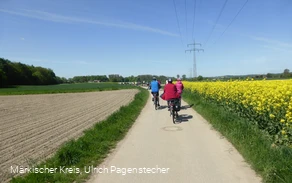- Bus stop available
- Free admission
- Open on request/by arrangement
Südengraben 28 / The house of the little people
Monument | Historic building
Shortly after 1700, plots of land along the city wall in Iserlohn were sold and released as building plots. The reason for this was the lack of space within the city wall and the now steadily growing population. The house at Südengraben 28 is also known as a wall house, as the city wall, which is around 1 m thick, was used for the rear and the roof construction rests on the top of the wall. The other three sides of the house are half-timbered.
Address
Südengraben 28 / The house of the little people
Südengraben 28
58636 Iserlohn
Properties:
Apart from minor repairs, the basic structure of the house remained unchanged between 1712 and around 1850. There was a "high kitchen" on the first floor behind the front door that extended up to the roof.
To the right of this, there was only one heated room as a living room.
A staircase at the back led to the unheated bedroom on the first floor. There would only have been a toilet in the form of a plum loo in the rear courtyard.
Washing was done with water from a nearby well.
The left half of the house was reserved entirely for the workshop of the craftsmen, most of whom lived in the house. For the flow of materials, there was a dormer window with a pulley and double flaps in the floor of the attic and on the first floor.
This meant that the raw materials could be stored in the left-hand half of the attic and then transported to the first floor inside the house for further processing.
There was originally a small flap in the outer façade through which the finished goods could be transported to the outside so that they did not have to be carried through the kitchen. When there were no craftsmen living in the house, this area was used as a stable.
Around 1860, a new owner took over the house and spent a lot of money on a new living and working structure.
The kitchen was now only on the first floor.
The living space above could be enlarged, and the staircase in the living room was moved to the area immediately to the left behind the front door to increase the living space. This reduced the workshop and stable area.
Four new and much larger windows were installed facing the street and the walls were decorated with stencilled décor in artificial ultramarine, which had just come onto the market.
A simple bathroom was installed in a niche in the stairwell on the first floor.
The aforementioned "boarders' room" was also created in the attic.
After 1945, the then owner, who had lived in this small house all her life, installed a shower in the former workshop.
After 1970, the roof was re-clad.
The dormer window was also removed in the process.
Every 1st Friday of the month (April-October), visitors can learn about the history of the house and its inhabitants. The city guides are also happy to include the topic in their tours.
To the right of this, there was only one heated room as a living room.
A staircase at the back led to the unheated bedroom on the first floor. There would only have been a toilet in the form of a plum loo in the rear courtyard.
Washing was done with water from a nearby well.
The left half of the house was reserved entirely for the workshop of the craftsmen, most of whom lived in the house. For the flow of materials, there was a dormer window with a pulley and double flaps in the floor of the attic and on the first floor.
This meant that the raw materials could be stored in the left-hand half of the attic and then transported to the first floor inside the house for further processing.
There was originally a small flap in the outer façade through which the finished goods could be transported to the outside so that they did not have to be carried through the kitchen. When there were no craftsmen living in the house, this area was used as a stable.
Around 1860, a new owner took over the house and spent a lot of money on a new living and working structure.
The kitchen was now only on the first floor.
The living space above could be enlarged, and the staircase in the living room was moved to the area immediately to the left behind the front door to increase the living space. This reduced the workshop and stable area.
Four new and much larger windows were installed facing the street and the walls were decorated with stencilled décor in artificial ultramarine, which had just come onto the market.
A simple bathroom was installed in a niche in the stairwell on the first floor.
The aforementioned "boarders' room" was also created in the attic.
After 1945, the then owner, who had lived in this small house all her life, installed a shower in the former workshop.
After 1970, the roof was re-clad.
The dormer window was also removed in the process.
Every 1st Friday of the month (April-October), visitors can learn about the history of the house and its inhabitants. The city guides are also happy to include the topic in their tours.
Business hours
On the first Friday of every month (April-October) from 4-5:30 p.m., you can learn about the history of the house and its inhabitants.
The city guides are also happy to include the topic in their tours.
Directions
Bus stop Schützenhof - Iserlohn (then walk 2 min.) or Fritz-Kühn-Platz - Iserlohn (then 5 min. on foot)






